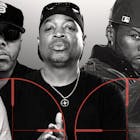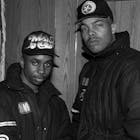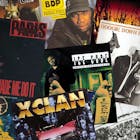
"By The Time I Get To Arizona:" How Public Enemy Pissed Off The C.I.A.
"By The Time I Get To Arizona:" How Public Enemy Pissed Off The C.I.A.
Published Thu, February 25, 2021 at 2:08 PM EST
*editor's note: This story was originally published 2/25/21
"By The Time I Get To Arizona" appeared on Public Enemy's 4th studio album, Apocalypse 91... The Enemy Strikes Black, which celebrates its 30th anniversary in October. The song continued Public Enemy's tradition of using music — specifically Hip-Hop — to educate listeners on social justice issues and call out inequities, hypocrisies, and straight up bullshit. As Chuck D has reminded us several times, the man just, "Don’t rhyme for the sake of riddlin’."
Public Enemy’s raps are like direct punches - straight jabs that come quickly, from all angles, and rarely off-target. It’s easy to close your eyes and see Chuck D boxing with the beat. His phrasing, his flow, and his delivery combine to float like a butterfly and sting like a bee.
“I think before I even get to the point where I'm able to cut the vocal in the studio, I envision where it should go, how it should sound, how it should feel, or going along when it goes on paper,” Chuck D says about his writing and recording process.
"By The Time I Get To Arizona" is a great example of that style, as Chuck weaves through bars that directly and indirectly address then-Arizona Governor Evan Mecham's decision to remove Martin Luther King Day as a paid holiday for the state’s workers. Chuck employs a variety of poetic techniques to link that decision to political representation, voter suppression, and the prison industrial complex. Words are meticulously chosen and delivered.
“I always knew how to carefully write the language, have double-entendres, add some slang, a little patois, spit it out on top of beats,” Chuck says. “And when they sat it down, spread it out and they read it and examined it, it was kind of ambiguous at the same time.”
If Chuck D’s bars are coded and a bit ambiguous, the song’s intro by Sistah Soulja is the exact opposite. She begins the record as cutting and as clear as could be, and exactly outlines its purpose: “Public Enemy believes that the powers that be in the states of New Hampshire and Arizona have found psychological discomfort in paying tribute to a black man who tried to teach white people the meaning of civilization.”
Bingo. A clear thesis and a large reason that song holds relevance today. As much as things have changed in America (and specifically Arizona), much remains the same. At the top of that list is a general refusal to accept the truth, and instead to stick to a “Make America Great Again” narrative that fails to acknowledge America’s failed ability to ever achieve greatness.

Yeah, he appear to be fair/ The sucker over there, he try to keep it yesteryear/ The good ol' days, the same ol' ways that kept us dyin'.”
- "By The Time I Get To Arizona"
The music video was even more explicit and catapulted the song to a new level of awareness.
“The song took off with the video as opposed to just the song,” Chuck recalls. “In the song I could say a lot of things that people wouldn't notice right away. But when we showed the video, the video was immediately impactful.”
In the music video, director Eric Mazer, Hank Shockley, and Chuck D contrast '60s Civil Rights Marches as Chuck D and Public Enemy plan and execute takeover of government buildings and assassination of elected officials responsible for oppression.
“I was talking about a take-over of a very blatant, one-sided, heinous situation that was all fantasy," he says. "I pushed my fantasy button when it came to filmmaking. We made an impactful statement at that particular time.”
The video could not be ignored. It was quickly condemned by conservatives and banned from TV. The message was already out there though, and Public Enemy received tremendous support from the artist community. The song helped in national efforts to make MLK day a holiday everywhere. It put pressure on other artists to boycott the state, and had to play some role in the NFL’s decision to pull the 1993 Super Bowl from Phoenix.
The song and video definitely struck a nerve. To recognize Martin Luther King Jr. Day is to recognize MLK's role in the Civil Rights Movement; and in doing that, forces us to recognize the evil that MLK fought to end. It is a conversation a lot of folks did not want to have in 1991, and it's a conversation that many still don't want to avoid at all costs. It took a vicious pandemic, and a summer of riots and civil unrest for America to wake up and recognize the racism and white supremacy that is embedded in the very DNA of this country.
“By The Time I Get To Arizona” and Public Enemy’s catalog resonates in 2021 because so many of the concepts that they have addressed for over 30 years, have only recently hit a wide American consciousness.
"Before we came along there was this sort of intention to keep rap and Hip-Hop hop into this urban box that only talked about adolescent dance things," says Chuck. "And at the end of the day, you can ask Bob Dylan, Phil Ochs all the questions about how the world works and what's hypocritical in the world, or even CSNY, why couldn't rap music make the same commentary about what we saw wrong?"
DROP YOUR EMAIL
TO STAY IN THE KNOW
Hip-Hop artists are continuing that trend in 2021, and reports show that the public is listening and demanding that more artists speak to current conditions. According to the Nielsen Mid-Year Report, songs such as Childish Gambino’s “This Is America”, Kendrick Lamar’s “Alright”, N.W.A.’s “Fuck The Police”, and Rage Against The Machine’s “Killing In The Name” all saw streaming spikes of 200-600% during the summer of 2020. Artists ranging from Run The Jewels to Lil’ Baby released protest records that spoke to a fed-upness with current conditions that was no longer going to be ignored.
“Rap music right now should be like Public Enemy stuff, but it’s just not there,” Madlib told the Guardian. “I wish it was more like how it was in the earlier days when I was coming up. My influences. Real music. Music can teach you … things not to do. Most of the music today is telling you bad things to do. My type of Hip-Hop can help you grow up.”
Madlib is spot on with the need for music that is suited for a revolution or songs that can fill in the gaps of the American education system. But for Chuck D, the aesthetic and mission of Public Enemy is alive and well.
“I think there's a lot out there. There's so much out there,” he tells me without hesitation and with big props and respect for Madlib. “When you say ‘Public Enemy’ or [Chuck D], I got 116 countries under my rap belt. There's Hip-Hop music all over the world that speaks to the urgency of the area where it's at. We just had a famed MC in the country known as Spain who's threatened to be jailed for his lyrics against the government, and his infectious incendiary music as well. That's Public Enemy.”






